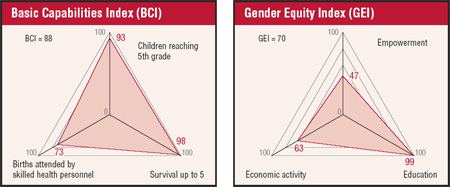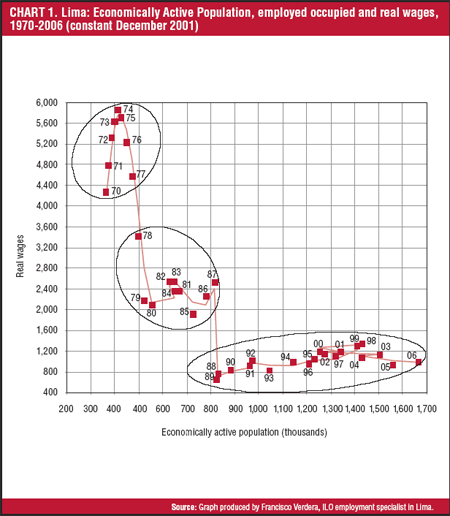The workers' proposal
The workers’ proposal
Confederación General de Trabajadores del Perú (CGTP)
Support from CEDEP
Mario Huamán Rivera1
The Government’s economic stimulus plan for tackling the crisis adds USD 3 billion to this year’s budget, which the Government will spend - in partnership with private-sector employers - on housing construction, financing for the export sector, and social welfare programmes. The trade union confederation has issued an alternative plan designed to maintain economic expansion and job creation, preserve jobs, support the worst-off sectors of society and encourage growth and consumption of domestic production.
 |
Peru has not been spared from the effects of the global crisis. GDP growth, which reached almost 10% in 2008, but was down to less than 4% in January 2009, according to the National Institute of Statistics and Information Technology. Exports are expected to plunge from USD 32 billion in 2008 to around USD 22 billion this year. The country’s President declared that this will lead to 200,000 layoffs, as well as a fall in the purchasing power of wages and savings. The worst affected sectors are the mining, industrial manufacture of non-primary resources, agribusiness, trade and services sectors. Unless the Government responds swiftly and effectively, the downturn will worsen in the second half of the year.
The current official economic stimulus plan adds 10 billion Peruvian soles (PEN), equal to almost USD 3.4 billion, to the 2009 budget. The Government will raise this money by issuing sovereign bonds and spend it, in partnership with private-sector employers, on housing construction, finance for the export sector, and social welfare programmes valued PEN 500 million (USD 169 million).
When times are good, workers are typically asked to wait patiently for the benefits of growth; in times of crisis, they are expected to tighten their belts. But counteracting the damage caused by this crisis requires boosting domestic demand by increasing workers’ consumption and protecting national production, as well as suspending free trade agreements (FTAs) that leave the Peruvian market far too open at a time of shrinking international markets.
The graph that follows shows the dramatic fall in real earnings among the economically active population of Peru during the period 1970-2006, calculated in Peruvian soles [USD 1 = soles 2.95 in July 2009] per annum. While the average worker was paid 6,000 soles per annum in 1974, by 2006 the average worker was earning 1,700 in real wages, less than a third as much. The slight recovery in the period following the adoption of the neoliberal model in 1990 fell far short of what workers gained during the 1970s, when the State applied a Keynesian model and was actively involved in the economy, trade union organization, collective bargaining and ensuring job security.
 |
The CGTP proposal
In response to the crisis, the CGTP, working with a group of economists, has issued an alternative proposal2, addressed to both the Government and the general public.
1) Objectives. Instead of allowing a recession to deepen, the country should respond to the crisis by encouraging a new kind of economic growth; by promoting job creation and job security, rather than by accepting mass layoffs. We believe it is possible to stimulate growth that is based on consumption of goods produced domestically and well-balanced exports. State investment should focus on productive sectors of the economy, as well as regions that have sustained massive job losses, with particular attention to the needs of the poorest sectors of society, children and the elderly.
2) Specific policies. The plan requires Government action in the following areas: fiscal policy, stimulating the domestic market, promotion and protection of decent employment, increasing agricultural productivity and food sovereignty, encouraging small businesses and protecting the poorer sectors of the population.
a) Fiscal policy. As a counter-cycle measure to provide incomes for poor families who are consumers of national products, the State should boost public spending on infrastructure projects that can be completed quickly and create substantial employment. This stimulus package should be accompanied by the introduction of redistributive tax policies, including direct taxes to finance the proposed measures, as well as an extraordinary tax on the net worth of mining companies and capital gains to compensate for a reduction in tax revenues from other sources. Fuel taxes, which make up as much as 40% of the price of petrol and oil, should be cut. This would lead to reductions in food and transport prices, which would increase both demand and small business competitiveness.
b) Defending national production to stimulate the domestic market. We propose a special plan for regional investment of public funds, removing bureaucratic barriers while providing mechanisms to ensure transparency in public and private expenditures. Implementation of free trade agreements (FTAs) that affect national production must be suspended. The country should impose tariff and quasi-tariff measures to protect domestic production and Peruvian jobs against subsidized imports. To help rebuild household earnings, we need an agricultural credit and micro and small enterprise (MSE) programme offering reduced interest rates, as well as measures to increase the availability of mortgage credit to people of low or average income. International reserves should be husbanded and the value of the Peruvian sol should be allowed to slide gradually to improve business competitiveness and the trade balance.
c) Protecting decent jobs. The Government should promote collective bargaining and trade union freedom, along with tripartite commitments, negotiated by workers and employers in each industry and government in order to maintain employment. It needs to introduce a job retraining programme for workers laid off as a result of the crisis, financed by the Fiscal Stabilization Fund and international development assistance. These workers should also be given temporary unemployment insurance. Tax incentives should be offered to businesses sponsoring job training programmes and investing in technological innovation.
d) Raising agricultural productivity and defending food sovereignty. The Government should promote a coordinated policy to increase productivity in agriculture and livestock farming. This should include re-establishing price controls, as well as the imposition of anti-dumping tariffs and special taxes on food oligopolies. The Government should also widen access to credit and refinancing for the agricultural sector and repeal the legislative decrees that facilitate land acquisitions that dispossess peasant and Amazonian communities.
e) Defending micro and small enterprises (MSEs). The Government should give preference to MSEs as suppliers and expand financing for these enterprises by increasing the Financial Corporation for Development’s allocations to the Fund to Guarantee Loans to Small Business.
f) Protecting the poorest. Government should launch temporary employment programmes that improve productive infrastructure and basic health, education and nutrition services. It should also provide cash transfers for peasants and poor livestock farmers who are not involved in temporary employment programmes, so they can prevent their land and animals from being auctioned off. In addition, it should provide state pensions for people over 65 years of age who have no income, and introduce a universal health insurance system that guarantees quality care.
The CGTP proposal supports economic integration and trade at the regional and sub-regional level, as well as internationalization of Peruvian companies and market diversification.


